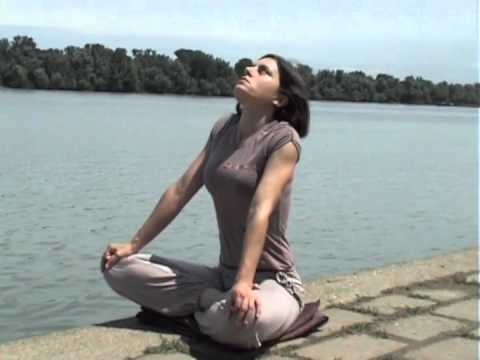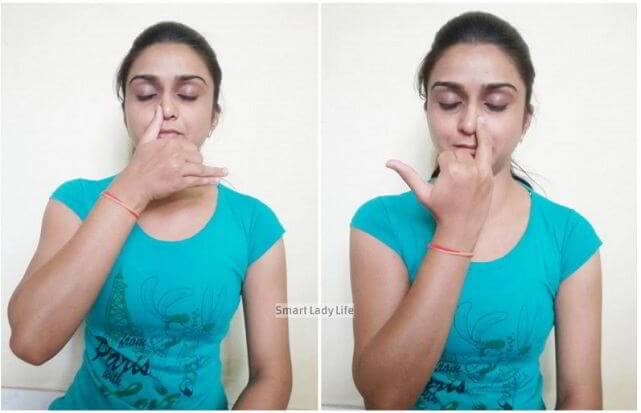Bhramari Pranayama
Bhramari Pranayama is a powerful breathing technique mentioned in the yogic literature. It can balance the thyroid glands and thymus glands and also improve the functioning of different parts of the body. Read on to learn more about it here.
What is Bhramari Pranayama?
Bhramari Pranayama, also known as the Humming Bee Breath can be described as a breathing practice which helps to calm and soothe the autonomic nervous system. It also enables us to connect effectively with our authentic inner nature. The term “Bhramari” is derived from the Sanskrit term used for meaning “bee”. The pranayama is named in this way for the humming sound that is produced around the back section of the throat. The breathing pattern helps to produce an intense calming and chilling effect on the mind. It also helps to prepare the body and mind for meditative purposes.
Steps of Bhramari Pranayama
Here are the main steps associated with Bhramari Pranayama.
- Sit on the ground and close your eyes. Choose a well-ventilated area to practice Bhramari Pranayama.
- Focus on your breathing and observe the various changes and sensations you feel within your body. Keep the eyes closed as you focus on your inner quietness. This will help you to remove distractions imposed in your mind from the external world.
- Put the index fingers gently on your ears on touch the cartilage present between the ear and cheek. Put mild pressure on them as you perform Bhramari Pranayama.
- While pressing on the cartilage gently, breathe in deeply and then exhale. At this stage, make a loud bee-like humming sound.
- The pitch and intensity of the sound may vary from low to high. It is a good idea to experiment with multiple pitches to see which one you are most comfortable with. While a high pitched sound generally produces better results, the low pitched ones come with their own benefits as well.
- Repeat this breathing pattern for about 4 to 5 times.
There are also a number of variations associated with Bhramari Pranayama that you can try out. For instance, you can practice Bhramari Pranayama while keeping the thumbs on the tragus, the middle fingers touching the sides of your nose, the index fingers over your eyes and ring fingers just above your lips with your pinkies placed just below. The pressure on eyeballs should be maintained very light.
Make sure that you observe the way the vibration of the bee breath circulates through your brain and the upper section of the body in general. You may also chant Om as you perform this breathing exercise. There is also a silent variation of Bhramari Pranayama where you need to simply imagine producing a buzzing sound during your exhalations. The benefit of the silent variation is that you can practice this anywhere you want, even when you are traveling by bus or sitting on a park bench.
Performing Tips
Bhramari Pranayama must always be practiced on a vacant stomach. Even though you can practice this breathing exercise at any hour of the day, the best times to perform this would be during the early morning hours or late at night. This is so because during these hours the distractions on our senses are fewer and our inward perceptions are heightened.
Make sure that you perform Anulom Vilom Pranayama before you practice Bhramari Pranayama. It is important that you perform this breathing technique under the direct supervision of a professional yoga teacher. Do not put excess pressure on your ear cartilage and keep it light. Do not put pressure inside your ear. Also, do not practice Bhramari while lying down or in the supine position.
The science behind Bhramari Pranayama
Bhramari Pranayama is a very safe and easy breathing technique that can be learned by anyone. It also offers tremendous healing and therapeutic results. It has a major impact on the ANS or autonomic nervous system. Lengthening the overall time for exhalation in relation to inhalation helps to calm the parasympathetic nerves of ANS. People suffering from nervousness and anxiety can experience instant calmness and a sense of relief when they practice Bhramari Pranayama. A major benefit associated with Bhramari Pranayama is that the bee breath or buzzing sound can help to silence the constant mental chatter that causes emotional suffering. This can be a great start for anyone who is eager to meditate but hardly can’t due to the incessant activities of the restless brain.
An important point to note about the Bhramari Pranayama is that it impacts the throat chakra and the various organs present in that area. This means that by practicing this pranayama one can enjoy improved functioning of thymus glands and thyroid glands. The thymus glands are indirectly responsible for producing lymphocytes or white blood cells in the body. While only weighing 15 grams during our birth, the thymus becomes double its original size by the time a child is 12 years old. However, as people enter adulthood, the thymus starts to shrink, eventually becoming very small by the time people hit their 30s. It also gets covered by a layer of fatty cells which makes it difficult to function properly.
Most modern scientists believe that the thymus plays a very insignificant role in producing T cells by the time people reach adulthood, as during this stage the same function is managed by the spleen and the lymph nodes. However, yoga science says otherwise. According to yogic literature, the thymus, as well as the components and energies in this area, have a very important role to play in protecting the mind and body from harmful and adverse conditions. While during the early years the thymus offers a powerful immune system to a child and provide with endless mental creativity, it plays an even more important yet subtle role as physical growth comes to a halt. This role involves the supporting of emotional maturity. This makes it possible for adults to develop various qualities such as good judgment, patience, fortitude, balance, compassion and forgiveness which help a person to have a balanced mind and reduce the ill effects of psychological disturbances. Both of these functions have a positive effect on our health. Therefore the practice of Bhramari Pranayama not only ensures positive health for the thymus but also restores emotional balance.
Benefits of Bhramari Pranayama
These are the main benefits of practicing Bhramari Pranayama.
- Bhramari Pranayama is a highly effective method for enhancing mental concentration and focus.
- This pranayama can open the various energy blockages in our body provide us with a feeling of elation, relaxation and happiness for the mind and body.
- It is highly beneficial in resolving the signs and symptoms of hypertension.
- Bhramari Pranayama can lower stress and relax the mind. It works powerfully to resolve any signs of anger, frustration, depression and all kinds of negative emotions.
- It can cure all kinds of throat ailments.
- Bhramari Pranayama can bring you comfort if you are suffering from headaches or a feeling of hotness.
- The breathing technique is extremely effective for men and women suffering from thyroid problems and insomnia.
- It helps to combat high blood pressure as well as all resulting heart problems.
- It is a perfect breathing technique to steady the mind and minimize agitation and mental tension.
- The pranayama can help to heal migraines and paralysis.
- It is one of the best breathing exercises for boosting memory.
- Women practicing this pranayama can have improved functioning of the Endocrine system which can ensure smooth and hassle-free childbirth. However, women should not practice this during their pregnancy months.
- It is a perfect breathing technique for managing Alzheimer’s disease.
- The calming of the mind achieved through Bhramari Pranayama can prepare the body and mind for meditation.
- This breathing technique can stimulate the pituitary and pineal glands and improve their functioning.
- It can improve and strengthen our voice, which is why it is highly recommended for singers and actors who need to use their voices articulately.
- When practiced regularly, this pranayama can heal our bodily tissues
- It improves the quality of our sleep.
- It can help to ease nasal congestions and heal sinus infections.
- This pranayama offers a lot of spiritual benefits and can help to awaken Kundalini energy.
Precautions associated with Bhramari Pranayama
Bhramari Pranayama is contraindicated for people suffering from epilepsy, high blood pressure, heart problems, chest pains or some kind of active ear infection. Menstruating or pregnant women should never practice Bhramari Pranayama.
So now that you are well aware of the various benefits and elements of Bhramari Pranayama, go ahead and start practicing it on a regular basis.
Bhramari Pranayama Video
References

VI FITKIT Yoga Mat Anti Skid EVA Yoga mat with Bag for Gym Workout and Flooring Exercise Long Size Yoga Mat for Men and Women (Color - Blue)
Price: Rs 399.00 FREE Delivery. Details
About The Product
- With high density foam material, The thick ( 3 mm thick ) premium mat with comfort cushion spine, hips, knees and elbows on hard floors. This makes it a perfect size for both men & women.
- SWEAT RESISTANT AND WASHABLE YOGA MAT - Next time don’t stress when you sweat while doing yoga. The yoga mat is completely sweat resistant and has a Moisture resistant Technology which makes the mat easily washable with soap and water.
- This Yoga Mat is designed to give you the most comfortable yoga experience possible. The extra thick mat protects joints without compromising support or stability
- DURABLE & ECO FRIENDLY YOGA MAT - The EVA material is extremely durable and eco friendly. It lasts upto 5 times more than a regular plasticky mat! The material is biodegradable and free from PVC, silicon, latex and other toxic materials. We believe in creating quality and Eco friendly products for our customers!
- Care Tips: Do not place in washing machine or dryer, Please clean before and after using, clean regularly and keep it dry for healthy using.




